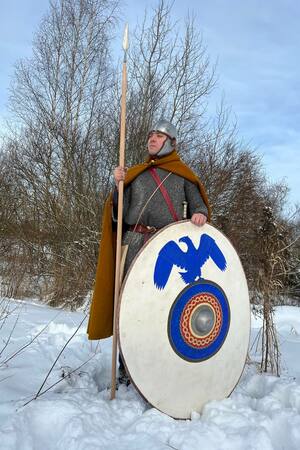Comitatensis
Comitatensis
The adjective "Comitatensis" (plural: Comitatenses) is derived from the Latin word "comitatus," meaning "retinue" or "suite." In the 1st and 2nd centuries AD, "comitatus" referred to the retinue of Roman emperors, consisting of their friends and associates.
By the late 3rd century AD, the term "comitatus" still denoted the personal guard of the emperor.
The designation "comitatenses" as a distinct class of soldiers is first attested in Emperor Constantine's decree of 325 AD, and it implies the most privileged part of the army. However, the context suggests that in 325 AD, the comitatenses were still soldiers who were currently serving directly under the emperor's command.
Ammianus Marcellinus, a military commander and historian of the late 4th century AD, also mentions comitatenses as troops under the emperor's personal command and directly serving with him.
Over time, as emperors ceased to personally participate in military campaigns and increasingly delegated the command to their generals, the term "comitatenses" ceased to denote the personal troops of the emperors. By the beginning of the 5th century, the term "Comitatensis" became a honorary title awarded to distinguished military units that were not part of the emperor's personal guard. This understanding of the term persisted until the fall of the Western Roman Empire in 476 AD.
For example, in the 4th century, Legio XIIII Comitatensis served on the Danube as part of the ripenses – a river fleet, infantry, and coastal border forces. This clearly classifies this legion of comitatenses as limitanei. Thus, the clear division of the late Roman army into stationary limitanei and mobile field armies of comitatenses, accepted since the time of Delbrück, now appears to be an oversimplification that may not fully reflect the actual situation.
Related topics
Dominate, Soldiers of the Roman Empire in the Dominate era, Late Roman Empire, Limitans
Literature
1. Ammianus Marcellinus, Roman History (Res Gestae), XXI, XXXI
2. Codex Theodosius and the Novellas of the Emperors Valentinian III, Majorian, and Libius Severus on coloniae, rural slaves, and freedmen.(translated by A. Koptev from the edition: Theodosiani libri XVI cum constitutionibus sirmonlianis et leges novellae ad Theodosianum pertinentes. Ed. Th. Mommsen et P. Meyer. Berolini, 1905. Vol. I-II.)
3. Bannikov A.V., Military reforms of Diocletian/The ancient state. Political relations and State forms in the Ancient world//Collection of scientific articles. Edited by profesor E. D. Frolov. St. Petersburg, 2002.
4. Bannikov A.V., Roman army in the IV century (from Constantine to Theodosius) / A.V. Bannikov. - St. Petersburg: Philological Faculty of St. Petersburg State University; Nestor-Istoriya, 2011. - 264 p., ill. - (Historia Militaris).
5. George Baker, Constantine the Great. The First Christian Emperor / Translated from English by L. A. Kalashnikova, Moscow: ZAO Tsentrpoligraf, 2004, 351 p.
6. Mekhamadiev E. A., Military organization of the Late Roman Empire in 253-353: the Epoch of Constantine I the Great and his Dynasty (306-353), St. Petersburg: Peterburgskoe Vostokovedenie, 2019, 424 p.
7. Kholmogorov V. I. Roman strategy in the IV century AD by Ammianus Marcellinus //VDI, No. 3, 1939. pp. 87-97; On. Field army (Comitatenses)of the Roman Empire of the IV century AD. Issue No. 12. No. 86. P. 81-100.
8. Southern, Pat. The Roman Empire from Severus to Constantine. — Routledge, 2001.



